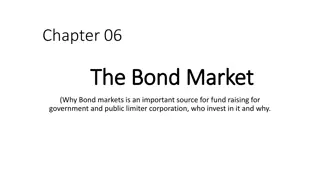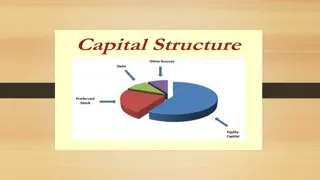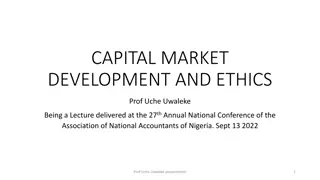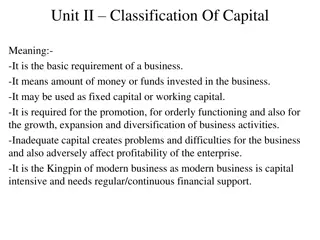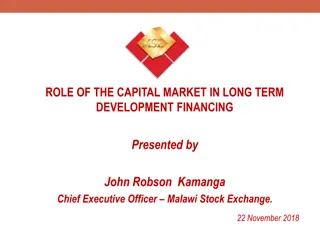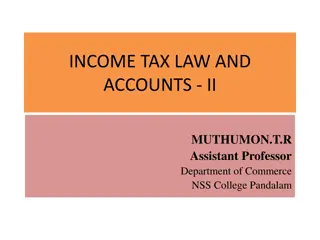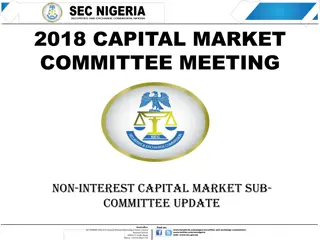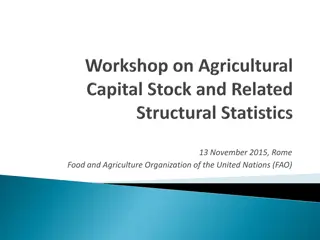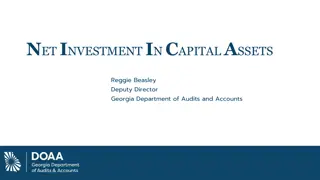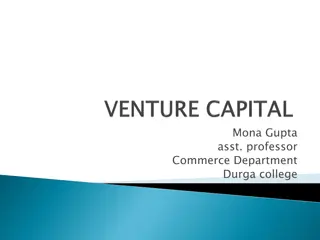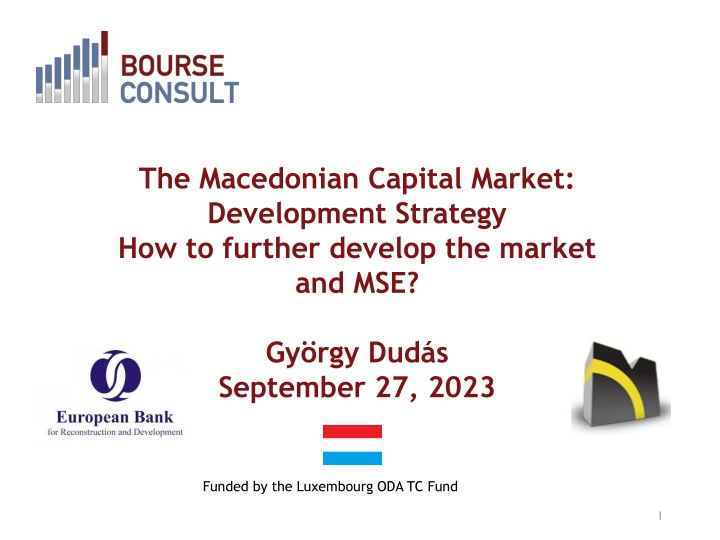
Development Strategy for Macedonian Capital Market
This document outlines a strategy for further developing the Macedonian capital market, focusing on key areas such as the legal and regulatory environment, government securities market, demand and supply side dynamics, market infrastructures, and financial literacy. It highlights barriers hindering market growth and provides recommendations to enhance confidence, expand investable assets, address legal obstacles, and improve financial literacy levels. By addressing these challenges, the aim is to foster a robust capital market environment in North Macedonia.
Download Presentation

Please find below an Image/Link to download the presentation.
The content on the website is provided AS IS for your information and personal use only. It may not be sold, licensed, or shared on other websites without obtaining consent from the author. If you encounter any issues during the download, it is possible that the publisher has removed the file from their server.
You are allowed to download the files provided on this website for personal or commercial use, subject to the condition that they are used lawfully. All files are the property of their respective owners.
The content on the website is provided AS IS for your information and personal use only. It may not be sold, licensed, or shared on other websites without obtaining consent from the author.
E N D
Presentation Transcript
The Macedonian Capital Market: Development Strategy How to further develop the market and MSE? Gy rgy Dud s September 27, 2023 Funded by the Luxembourg ODA TC Fund 1
Why am I here today? Bourse Consult is legally a UK based Partnership, but we like to define ourselves as a European firm of consultants specialised in capital markets. What is unique is that we are all senior capital market professionals with decades of hands-on experience. Colleagues on this assignment: Hugh Simpson We were invited by EBRD to prepare a Market Development Strategy for the Macedonian Stock Exchange A work in progress, with the first, assessment phase now largely finalised and currently working on the second phase to develop a market development strategy and business plan for the Macedonian Stock Exchange Raymond Sabbah and myself (Gy rgy Dud s) 2
1. The Legal and Regulatory Environment for Capital Market What is the regulatory and legal environment in place to support the Capital Markets landscape in North Macedonia? Market Assessment: 2. The Government Securities Market What is the state of development of the government securities market in the country? When assessing the current state of development of the Macedonian capital market, we looked at the following areas or building blocks: 3. The Demand and the Supply side Who invests in the Macedonian securities market, and what types of securities are available? 4. Market Infrastructures What are the infrastructures needed for the functioning of a modern Exchange and Capital Markets? 5. The Zagreb (ZSE) Story What is the current relationship and possible future development between MSE and ZSE? 6. Financial Literacy What is the level of financial literacy of local investors/entrepreneurs? 3
The Macedonian vicious circle Less effort to sell the CM to issuers, investors Lower level of financial literacy Low business case for ISP development Risk averse investors Lack of gov t secs secondary mkt No IPOs Cheap bank finance for enterprises Low level of confidence in CM No support mechanism for SME growth Low level of investment in local CM products Low liquidity in local CM Looking for (local or cross-border) alternatives 4
The Key Barriers in front of the further Development of the Macedonian Capital Market #1 low level of confidence in the market, lack of investors To address this: need to develop the regulatory and legal environment, strengthen the demand side and increase the number of investors #2 shortage of investable assets, lack of issuers To address this: need to build an ecosystem that supports the lifecycle SMEs, need to strengthen the supply side and increase the availability of investable assets (more issuers and more issues) #3 legal and regulatory barriers To overcome these: need to develop the regulatory and legal environment to support investors, investments and potential issuers #4 medium level of financial literacy To improve this: need to promote initiatives that raise the level of financial literacy for both investors and issuers 5
How can you tackle this vicious circle? To revive a capital market that has many ingredients already in place, has seen better days, but is dormant and not working properly in several aspects is a big challenge. Maybe bigger than to develop one from scratch. To break this negative spiral you need a consistent, coordinated approach of both private and public sector stakeholders with serious and long-term commitment, investment in time, effort and money by all parties. And while some of these actions can be taken fairly quickly, market infrastructures can be developed relatively quickly, to see the results of creating more efficient and deeper markets take decades. 6
Long Term Actions (4+ yrs, cont.) 4. Review North Macedonia s sectoral regulatory/supervisory model Overall Objective Intermediate Objective I. On the way to EU accession. Develop Capital Market regulatory environment Short Term Actions (1-2 yrs) 1. Consider supporting investment on the domestic market through more favourable taxation: reconsider capital gains taxation, taxation for long-term investments (see also II.4 ISA accounts), ESG investments, and taxation of premiums paid for life insurance, voluntary life insurance and voluntary pension funds by employers for employees (see also II.1). Medium Term Actions (3-4 yrs) 2. To raise the level of confidence, continue to harmonise capital market legal framework to that of the EU. Financial market consumer protection. Protection of shareholder rights. 3. Implement rule regarding OTC trades to be reported to MSE within x minutes of trade. MSE to publish OTC trade data. II. Demand side - increase number of investors 1. Develop institutional investors and their investment activity on the domestic market. Review existing investment limitations by institutional investors (eg. into growth companies, private placement bonds or Macedonian Eurobond issues). Strengthen voluntary pension funds pillar. Consider introducing risk-appetite related portfolios and introducing life-cycle funds. 2. Make investments into local securities attractive for individual investors. Prioritise on the young generation. Create products (eg. government securities targeted to private investors, strengthen collective investment schemes) and favourable investment opportunities (see also II.4) 3. Make MSE (and the Macedonian capital market) more accessible to foreign investors 5. Increase financial literacy in capital markets - investors (private investors, young generation ) 4. Develop Individual Savings Account (ISA) products with tax benefits Enhance attractiveness of the Macedonian capital market III. Supply side - increase number of issuers 1. Explore opportunities for public sector entities to raise finance through bond issues or through listing minority stakes in some SoEs, even considering technical listings at MSE. 3. Support companies throughout lifecycle: angel/crowdfunding phase, venture capital and private equity phase, listing at SME growth market. Consider allowing pension funds to invest into SME growth market securities. 4. Strengthen corporate governance. Improve corporate disclosure/transparency. 5. Develop corporate bond (incl. SOEs) and municipal bond market. Create opportunity to develop fixed income fund products - enhance investments into low/moderate risk products 6. Increase financial literacy in capital markets - issuers (company owners, management...) 2. Review process (burden), timing and costs of companies going public (listing) IV. Increase trading activity1. Develop MSE international segment 6. Transform the government secondary market to a firm market making venue. Create government bond secondary market liquidity. Create a bond yield curve as the basis for pricing other assets. Develop interbank repo market. 7. Improve capital market awareness 2. Develop CDHV cross-border links 3. Develop a healthy government bond market. Create a Primary Dealership (PD) framework. 4. Develop post-trade services to support MSE trading, interbank repo market needs 5. Create analytical coverage of listed companies 7
(1) Legal and Regulatory Environment You need a supportive legal and regulatory environment On the way to EU accession continue to harmonize the Macedonian capital market legal environment with that of the EU Keep protection of shareholder rights, transparency and the strengthening of corporate governance in focus Create incentives for investors to invest on the local capital market tax incentives Create incentives for issuers to seek financing from the capital market, make listing cheap, easy and quick Start the revision of the Capital Market Strategy 2022-2024 Consider revisiting the sectoral supervisory model and build capacity with highly knowledgeable staff 8
Taxation to support Capital Markets Capital Gains Tax North Macedonia 10% tax base: 90% of realised capital gain Albania Serbia Armenia Georgia Bulgaria 15% 15% 0% 20% 0% carry forward of capital losses is available for 5 yrs capital gain derived from the sale of shares through Bulgarian SE or regulated mkt in EU/EEA member state are exempt Croatia Slovenia 10% 25% 5+ yr holding: 20%, 10+ yr holding: 15%, 15+ yr holding: 0% Consider developing Individual Savings Account (ISA) programmes UK example: a generous GBP 20,000 can be invested in a tax year into 4 different types of ISA accounts (cash, securities, innovative finance and lifetime) Hungary example: Long term ISA keep investments on account for 3 years to lower CGT to 10 % (and exempt from social contribution tax) and for 5 years to lower to 0 % (exemption from social contribution tax). Pension ISA (to support mandatory funds and pension insurance schemes) is similar, with a yearly benefit of 20 % of investment (max. cca 400 EURs). Others, like supportive taxation for ESG products, voluntary pension fund investments and life insurance 9
(2) The Government Securities Market You need a well-functioning and healthy government securities market North Macedonia needs a Primary dealership system for Government Bonds MSE should strengthen its role both on the Primary and the Secondary market trading with an ETP system with a firm market making for PDs to fulfill their obligations v-a-v MoF. Need for education. 10
North Macedonia needs an efficient Primary Dealership for Government Bonds A Primary Dealership system is an association between the issuer (The Ministry of Finance/State) and a group of banks (the Primary Dealers) by which there will be quoting obligations in the Secondary Market and incentives or privileges in the Primary Market. This creates a wholesale market with a high level of transparency and liquidity which radiates into greater liquidity for the rest of the market: all rates markets, corporate bonds and all quoted instruments. To achieve a high level of liquidity and for the MoF to monitor the quoting obligations of the Primary Dealers, an Electronic Trading Platform (ETP) is necessary. This ETP will have to meet certain requirements. The advantages of a liquid and transparent Primary Dealership are straightforward: The effect of creating a wholesale pool of liquidity in Government Bonds will positively affect all other securities markets, including equities, as the Government Debt market is a basic pillar of the Capital Markets. The savings in the cost of Public Debt is substantial. By creating such a market, the simple fact of having improved liquidity and market infrastructure (in pre-trade, trade and post-trade) considerably reduces the price of Debt for a country. This is the key aspect: it is known that without modifying the Macro situation, an improvement in liquidity and ease in negotiation and settlement, the savings can be considerable. 11
The implementation of the Primary Dealership For the Primary market a flexible auction system will be necessary and a clear and predictable issuance policy by the Ministry. For the Secondary market an ETP with the possibility of monitoring in real time the quoting obligations will be necessary. This ETP will be linked to the CSD for the settlement of the securities. In the Primary market there is a wide range of incentives that can be implemented: First of all, the Ministry must have a very clear and transparent policy of who can access the Primary auctions, in general they will be solely and exclusively the Primary Dealers. The auction system has to be transparent, with very clear rules. Regarding incentives in the way of accessing the Primary, the most common and most used by the Treasuries and Ministries are the non-competitive auctions. In the Secondary market, on the obligations part, there are basically 3 categories: Maximum spread between Bid and Ask prices: for the different maturities according to the benchmarks. Minimum volume in bid and ask: for each benchmark, the accumulation of bids in the queue just creates the desired liquidity. Minimum quoting time: it can be a number of hours during the day or a percentage of quoting time during the day. It is important to highlight that it is never advisable to force negotiated (traded) volumes. 12
Consequences for the Ministry of Finance and for the Banks For the Ministry: The Ministry creates a new relationship with the banks, a sort of partnership in the distribution of the Debt instruments to the market at large. The emphasis is not so much to cover the amounts at the Primary Market but to create an ecosystem where the institutional investors will have access to the prices and liquidity via the Primary Dealers. As such the MoF become much more active in the market, being directly involved in how the Government Bonds are distributed and sold. For the Banks: Market Making is a complex set operations that will need specific skills at the Banks. Investment in technology and human resources are necessary. But those market making operations that began in the 90ies have been extremely automated by banks and today a large variety of systems and algorithms exist. The advantage for banks lies in the benefit of having the spread between supply and demand protected by the market structure itself (institutional investors can only access the best Bids and Asks but not in the middle of the spread). Another very important advantage is that banks with this infrastructure have access to the flows, the large movements that move the markets. 13
Strengthen the role of the Stock Exchange in the Government Securities Market On the Primary Market CB is considering to abandon their role to organise auctions and thus MoF needs to look for new provider. MSE should strongly consider to come to an agreement with the MoF by offering a flexible primary market auctioning service On the Secondary Market broking an agreement with the MoF, the Central Bank and the PDs, MSE could provide an ETP platform for the PDs to meet their quoting obligations. Transform the secondary market to a firm, market making venue with primary dealers to increase liquidity and transparency. This creates a potential to build a data product and index product in the future and thus provides an extra revenue source for MSE. Implement a price driven platform allowing market making for PDs with firm prices to managing the PD quoting obligations of the MoF. Have a consolidated platform for Central Bank and interbank repo market. Provide a standing repo facility for PDs to borrow securities as a last resort thus supporting the PD s risk management function. Educational role to educate PDs, market makers 14
(3) Supporting SMEs You need an ecosystem that supports SMEs through their life-cycle The future of the capital markets lies in the small companies of today. According to the preliminary data of the State Statistical Office, the number of active enterprises in the Republic of North Macedonia in 2021 was 70,424. According to the number of employees, enterprises with 1-9 employees account for 82.5% of all enterprises, while those with 10-50 employees account for 7.7 % of enterprises. SMEs employ 74 % of the total Macedonian workforce (EU: 65 %) and the SME value-added is measured as 67,9 % (as opposed to the EU 53 %). 15
The missing ecosystem Earliest stage: business angels and crowd financing, crowd funding facilities Coordinate the incubation and acceleration efforts and initiatives of industry players and state-owned organizations. Investigate and prepare concept paper on how the Macedonian State could support the early-stage incubation and acceleration of local start-ups. Then moving up to venture capital and private equity financing Make coordinated market-level efforts to explore domestic and cross-border cooperation opportunities to set up new investment vehicles helping companies at different earlier stages of their growth While PE investments are booming in Europe, CSEE is lagging behind and VC/PE sector is practically non-existent in North Macedonia 16
And the next phase: SME Growth Market MiFID II created a new type of MTFs labelled as SME Growth Markets in 2018 MSE has a Growth Market segment, but currently there are no listed securities there Need for a strategic approach on how to attract issuers and investors to the growth segment. Such a strategic approach might include: Promoting the GM towards issuers and investors Providing SME education programmes (internal, based on MSE Training Centre or external, like entering into partnership with Elite) Ensuring a supportive regulatory framework for issuers and for investors Supporting SMEs to easily meet reporting requirements Providing financial support programmes to apply for taking part in training and/or support the preparations for listing at SME GM Providing networking opportunities and partnership events (MSE Club Initiative) Building up international partnerships (eg. Elite or with other SME GMs) Follow closely the upcoming EU Listing Act Consider permitting pension funds to invest into securities listed on SME GM 18
(4) And You need to do a lot-lot more To increase the availability of investable assets The public sector (SOEs, municipalities) might consider accessing the capital market. Technical listing. Bond/ESG bond issuance. Listing minority stakes. Stakeholders should support the development of a functioning corporate bond market by raising awareness among SMEs. Raise awareness of potential issuance of covered bonds by banks. Encourage development of local fixed income funds. MSE to develop international securities market for local investors (MTF?) To build trust and support potential investors Raise standards of corporate governance training courses, acknowledgement and publicity to best practices Issuers need to build capacity for professional Investor Relations (IR) function training courses, Annual IR Awards (see Baltic Awards) Brokers/banks to build capacity to prepare and publish high quality analysis/company research papers training, financial support, publicity 19
To attract foreign investors Issuer companies should make all information and notifications available in English on their websites MSE could work together with ZSE, LjSE to approach potential investors in Croatia, Slovenia, common initiatives To support market development CDHV might consider further develop post-trade services, risk management capabilities, default procedures should build capacity, knowhow and build cross-border settlement links (both as investor and as issuer CSD) To support the development of financial services at ISPs and further the level of financial literacy MSE could review the opportunity to develop MSE Academy to become the largest provider of financial market education services in North Macedonia follow the traits, learn from the experience of ZSE 20
Thank you! 21





